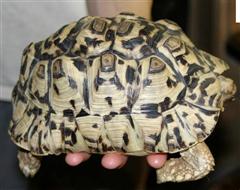Leopard Tortoise
African Leopard Tortoise, Tropical Leopard Tortoise Scientific Name: Geochelone pardalis babcocki
Sat, 14th June, 2025 - 6:35 pm GMT
Sponsor Ads:

Alternative Name
African Leopard Tortoise, Tropical Leopard Tortoise Scientific Name: Geochelone pardalis babcockiBasic Info
The African Leopard Tortoise can grow to lengths of nearly 28 inches, though lengths of about 18 inches are much more common.They can weigh up to 100 pounds, although most Leopard Tortoises do not exceed 50 pounds. The Leopard Tortoise's top shell, or carapace, is yellow or tan with black markings. The carapace is highly domed. Males are often smaller than females.
Health
Specific Care Information: Relative Care Ease: Average Leopard Tortoises require a large enclosure, and ideally should be housed outdoors whenever weather permits. Leopard Tortoises are solitary animals in the wild and may become if crowded. When many are housed together they need sufficient room to get away from one another and many hiding spots. Males should not be housed together because of their tendency to spar for territory and breeding rights.They should always have access to shaded areas no hotter than 90 degrees Fahrenheit, and at night they should not be left out in temperatures colder than 65 degrees. When sunny daytime temperatures are less than 70 degrees, the tortoises should be housed in heated shelters. If housing them indoors, during the day the temperature within the enclosure should range from about 80 degrees Fahrenheit at the cool end to 90 degrees Fahrenheit in the basking area. At night, the temperature should not fall below 70 degrees. They should be kept at low humidity levels, and they should be exposed to between 12 and 14 hours of full spectrum UV light per day. They can be provided with a shallow bowl of water large enough to soak in, or they can be soaked in shallow water periodically - about 3 times a week for those less than 1 year old and once a week for adults. Captive Leopard Tortoises should be allowed to graze. They do best with a diet consisting primarily of grasses. Their diet should be full of fiber and they should be given a calcium supplement. The diet can be supplemented with dark leafy green vegetables such as collards, kale, and turnip greens. Grape leaves, if available, are very nutritious and a good addition to the diet. They can also be fed fresh and dried alfalfa, but only in small amounts, as it is very high in protein. Fruit can be given in very small amounts, but should always be dusted with calcium. Breeding In the wild, Leopard Tortoises are usually not sexually mature until they are between 12 and 15 years of age. In captivity, the animals often grow faster and can be ready to breed between 6 and 8 years. Male Leopard Tortoises can be distinguished from females by their longer tails and more elongated bodies and sometimes by a slight concavity of their plastrons. Prior to copulation, male Leopard Tortoise usually rams and pushes the females. Once he mounts her, he begins making grunting noises. The average clutch size of the Leopard Tortoise is about 9 eggs, although clutches of up to 30 eggs have been reported. Females can lay over three clutches per season. Eggs should be incubated at about 80% humidity in a slightly damp medium. The eggs usually hatch between 130 and 180 days of incubation. Incubation temperatures can be between 82 and 88 degrees Fahrenheit (28 and 31 degrees Celsius), with lower temperatures typically resulting in longer incubation times. There are exceptions to every rule and some Leopard Tortoise eggs can take as many as 392 days to hatch.Habitat
warm climates.Behavior
The Leopard Tortoise is one of the largest and most personable tortoises. Being from Africa, the Leopard Tortoise does best in warm climates. They are herbivores that spend much of their waking hours grazing on grasses and succulents. They live in dry habitats with thorny and grassy vegetation. The Leopard Tortoise can sometimes be found in damper regions. In very hot or cold weather, the Leopard Tortoise retreats to burrows that were dug by fox, antbears, or jackals. The Leopard Tortoise's diet consists mainly of what it can find grazing and therefore it feeds mostly on grasses. They will also eat cactus and cactus fruit, when it is available.Origin
AfricaHistory
The Leopard Tortoise has been recorded in southern Sudan and Ethiopia, Uganda, the Somali Republic, Tanzania, Mozambique, Kenya, Malawi, Rhodesia, Zambia, Botswana, Transvaal, Natal, Cape Province, and Angola. There are two species of Leopard Tortoise, Geochelone pardalis babcocki, the most common Leopard Tortoise, and Geochelone pardalis pardalis, the South African Leopard Tortoise, which is a much rarer species.Common Foods
Captive Leopard Tortoises should be allowed to graze. They do best with a diet consisting primarily of grasses. Their diet should be full of fiber and they should be given a calcium supplement. The diet can be supplemented with dark leafy green vegetableSponsor Ads:
"A wind that rises in the daytime lasts long, but a night breeze soon falls." -- Sun Tzu, The Art of War
Leopard Tortoise
Coded by: BGID® | ALL RIGHTS RESERVED Copyright © 2000-2025
Disclaimer | Privacy | Report Errors / Contact | Credits








 Preparing For China. China is growing their military. China Military Technology - can it keep up with the US?
Preparing For China. China is growing their military. China Military Technology - can it keep up with the US?  versus
versus 

 versus
versus 
 This Thread is about the North Korean Military itself - the kind of army, navy, and air force they have.
This Thread is about the North Korean Military itself - the kind of army, navy, and air force they have. 
 versus
versus 
 versus
versus  versus
versus